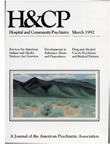Differences in Social Resources and Treatment History Among Diagnostic Groups of Older Adults
Abstract
Differences in demographic and social characteristics and treatment history of 407 patients age 55 or older were examined in relation to diagnosis. Seven diagnostic groups in three mental health service programs were studied, all of which were characterized by surprisingly high rates of previous treatment (75 percent overall). Patients in the dysthymia, adjustment disorder, and V code groups appeared to be the most similar and to have the greatest psychosocial resources and fewest indicators of chronicity. Schizophrenic and bipolar patients had the least resources and most indicators of chronicity. Substance abuse patients tended to live alone, while those with major depression seemed to have more resources and later onset of their illness than schizophrenic and bipolar patients. About half of those with milder diagnoses had received prior outpatient treatment, suggesting that perhaps past treatment success leads older adults to revisit mental health services.
Access content
To read the fulltext, please use one of the options below to sign in or purchase access.- Personal login
- Institutional Login
- Sign in via OpenAthens
- Register for access
-
Please login/register if you wish to pair your device and check access availability.
Not a subscriber?
PsychiatryOnline subscription options offer access to the DSM-5 library, books, journals, CME, and patient resources. This all-in-one virtual library provides psychiatrists and mental health professionals with key resources for diagnosis, treatment, research, and professional development.
Need more help? PsychiatryOnline Customer Service may be reached by emailing [email protected] or by calling 800-368-5777 (in the U.S.) or 703-907-7322 (outside the U.S.).



